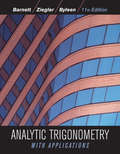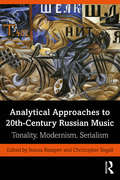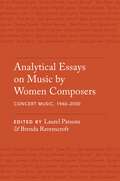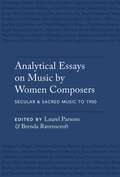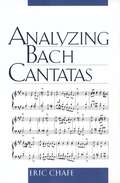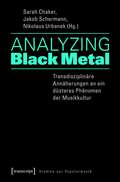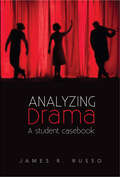- Table View
- List View
The Analytic Tradition in Philosophy, Volume 1: The Founding Giants
by Scott SoamesThis is the first of five volumes of a definitive history of analytic philosophy from the invention of modern logic in 1879 to the end of the twentieth century. Scott Soames, a leading philosopher of language and historian of analytic philosophy, provides the fullest and most detailed account of the analytic tradition yet published, one that is unmatched in its chronological range, topics covered, and depth of treatment. Focusing on the major milestones and distinguishing them from the dead ends, Soames gives a seminal account of where the analytic tradition has been and where it appears to be heading.Volume 1 examines the initial phase of the analytic tradition through the major contributions of three of its four founding giants—Gottlob Frege, Bertrand Russell, and G. E. Moore. Soames describes and analyzes their work in logic, the philosophy of mathematics, epistemology, metaphysics, ethics, and the philosophy of language. He explains how by about 1920 their efforts had made logic, language, and mathematics central to philosophy in an unprecedented way. But although logic, language, and mathematics were now seen as powerful tools to attain traditional ends, they did not yet define philosophy. As volume 1 comes to a close, that was all about to change with the advent of the fourth founding giant, Ludwig Wittgenstein, and the 1922 English publication of his Tractatus, which ushered in a "linguistic turn" in philosophy that was to last for decades.
The Analytic Tradition in Philosophy, Volume 1: The Founding Giants
by Scott SoamesThis is the first of five volumes of a definitive history of analytic philosophy from the invention of modern logic in 1879 to the end of the twentieth century. Scott Soames, a leading philosopher of language and historian of analytic philosophy, provides the fullest and most detailed account of the analytic tradition yet published, one that is unmatched in its chronological range, topics covered, and depth of treatment. Focusing on the major milestones and distinguishing them from the dead ends, Soames gives a seminal account of where the analytic tradition has been and where it appears to be heading.Volume 1 examines the initial phase of the analytic tradition through the major contributions of three of its four founding giants—Gottlob Frege, Bertrand Russell, and G. E. Moore. Soames describes and analyzes their work in logic, the philosophy of mathematics, epistemology, metaphysics, ethics, and the philosophy of language. He explains how by about 1920 their efforts had made logic, language, and mathematics central to philosophy in an unprecedented way. But although logic, language, and mathematics were now seen as powerful tools to attain traditional ends, they did not yet define philosophy. As volume 1 comes to a close, that was all about to change with the advent of the fourth founding giant, Ludwig Wittgenstein, and the 1922 English publication of his Tractatus, which ushered in a "linguistic turn" in philosophy that was to last for decades.
The Analytic Tradition in Philosophy, Volume 2: A New Vision
by Scott SoamesAn in-depth history of the linguistic turn in analytic philosophy, from a leading philosopher of languageThis is the second of five volumes of a definitive history of analytic philosophy from the invention of modern logic in 1879 to the end of the twentieth century. Scott Soames, a leading philosopher of language and historian of analytic philosophy, provides the fullest and most detailed account of the analytic tradition yet published, one that is unmatched in its chronological range, topics covered, and depth of treatment. Focusing on the major milestones and distinguishing them from detours, Soames gives a seminal account of where the analytic tradition has been and where it appears to be heading.Volume 2 provides an intensive account of the new vision in analytical philosophy initiated by Ludwig Wittgenstein’s Tractatus Logico-Philosophicus, its assimilation by the Vienna Circle of Moritz Schlick and Rudolf Carnap, and the subsequent flowering of logical empiricism. With this “linguistic turn,” philosophical analysis became philosophy itself, and the discipline’s stated aim was transformed from advancing philosophical theories to formalizing, systematizing, and unifying science. In addition to exploring the successes and failures of philosophers who pursued this vision, the book describes how the philosophically minded logicians Kurt Gödel, Alfred Tarski, Alonzo Church, and Alan Turing discovered the scope and limits of logic and developed the mathematical theory of computation that ushered in the digital era. The book’s account of this pivotal period closes with a searching examination of the struggle to preserve ethical normativity in a scientific age.
The Analytic Tradition in Philosophy, Volume 2: A New Vision
by Scott SoamesAn in-depth history of the linguistic turn in analytic philosophy, from a leading philosopher of languageThis is the second of five volumes of a definitive history of analytic philosophy from the invention of modern logic in 1879 to the end of the twentieth century. Scott Soames, a leading philosopher of language and historian of analytic philosophy, provides the fullest and most detailed account of the analytic tradition yet published, one that is unmatched in its chronological range, topics covered, and depth of treatment. Focusing on the major milestones and distinguishing them from detours, Soames gives a seminal account of where the analytic tradition has been and where it appears to be heading.Volume 2 provides an intensive account of the new vision in analytical philosophy initiated by Ludwig Wittgenstein’s Tractatus Logico-Philosophicus, its assimilation by the Vienna Circle of Moritz Schlick and Rudolf Carnap, and the subsequent flowering of logical empiricism. With this “linguistic turn,” philosophical analysis became philosophy itself, and the discipline’s stated aim was transformed from advancing philosophical theories to formalizing, systematizing, and unifying science. In addition to exploring the successes and failures of philosophers who pursued this vision, the book describes how the philosophically minded logicians Kurt Gödel, Alfred Tarski, Alonzo Church, and Alan Turing discovered the scope and limits of logic and developed the mathematical theory of computation that ushered in the digital era. The book’s account of this pivotal period closes with a searching examination of the struggle to preserve ethical normativity in a scientific age.
The Analytic Tradition in Philosophy, Volume 2: A New Vision
by Scott SoamesAn in-depth history of the linguistic turn in analytic philosophy, from a leading philosopher of languageThis is the second of five volumes of a definitive history of analytic philosophy from the invention of modern logic in 1879 to the end of the twentieth century. Scott Soames, a leading philosopher of language and historian of analytic philosophy, provides the fullest and most detailed account of the analytic tradition yet published, one that is unmatched in its chronological range, topics covered, and depth of treatment. Focusing on the major milestones and distinguishing them from detours, Soames gives a seminal account of where the analytic tradition has been and where it appears to be heading.Volume 2 provides an intensive account of the new vision in analytical philosophy initiated by Ludwig Wittgenstein’s Tractatus Logico-Philosophicus, its assimilation by the Vienna Circle of Moritz Schlick and Rudolf Carnap, and the subsequent flowering of logical empiricism. With this “linguistic turn,” philosophical analysis became philosophy itself, and the discipline’s stated aim was transformed from advancing philosophical theories to formalizing, systematizing, and unifying science. In addition to exploring the successes and failures of philosophers who pursued this vision, the book describes how the philosophically minded logicians Kurt Gödel, Alfred Tarski, Alonzo Church, and Alan Turing discovered the scope and limits of logic and developed the mathematical theory of computation that ushered in the digital era. The book’s account of this pivotal period closes with a searching examination of the struggle to preserve ethical normativity in a scientific age.
Analytic Trigonometry with Applications
by Raymond A. Barnett Michael R. Ziegler Karl E. ByleenBarnett, Analytic Trigonometry is a text that students can actually read, understand, and apply. Concept development moves from the concrete to abstract to engage the student. Almost every concept is illustrated by an example followed by a matching problem allowing students to practice knowledge precisely when they acquire it. To gain student interest quickly, the text moves directly into trigonometric concepts and applications and reviews essential material from prerequisite courses only as needed. Extensive chapter review summaries, chapter and cumulative review exercises with answers keyed to the corresponding text sections, effective use of color comments and annotations, and prominent displays of important material all help the student master the subject. Analytic Trigonometry 11th edition includes updated applications from a range of different fields to convince all students that trigonometry is really useful.
Analytical Approaches to 20th-Century Russian Music: Tonality, Modernism, Serialism
by Inessa Bazayev Christopher SegallThis volume brings together analyses of works by thirteen Russian composers from across the twentieth century, showing how their approaches to tonality, modernism, and serialism forge forward-looking paths independent from their Western counterparts. Russian music of this era is widely performed, and much research has situated this repertoire in its historical and social context, yet few analytical studies have explored the technical aspects of these composers' styles. With a set of representative analyses by leading scholars in music theory and analysis, this book for the first time identifies large-scale compositional trends in Russian music since 1900. The chapters progress by compositional style through the century, and each addresses a single work by a different composer, covering pieces by Rachmaninoff, Myaskovsky, Prokofiev, Shostakovich, Mansurian, Roslavets, Mosolov, Lourié, Tcherepnin, Ustvolskaya, Denisov, Gubaidulina, and Schnittke. Musicians, scholars, and students will find here a starting point for research and analysis of these composers' works and gain a richer understanding of how to listen to and interpret their music.
Analytical Essays on Music by Women Composers: Concert Music, 1960-2000
by Laurel Parsons and Brenda RavenscroftOver the past 30 years, musicologists have produced a remarkable new body of research literature focusing on the lives and careers of women composers in their socio-historical contexts. But detailed analysis and discussion of the works created by these composers are still extremely rare. This is particularly true in the domain of music theory, where scholarly work continues to focus almost exclusively on male composers. Moreover, while the number of performances, broadcasts, and recordings of music by women has unquestionably grown, these works remain significantly underrepresented in comparison to music by male composers. Addressing these deficits is not simply a matter of rectifying a scholarly gender imbalance: the lack of knowledge surrounding the music of female composers means that scholars, performers, and the general public remain unfamiliar with a large body of exciting repertoire. Analytical Essays on Music by Women Composers: Concert Music, 1960-2000 is the first to appear in a groundbreaking four-volume series devoted to compositions by women across Western art music history. Each chapter opens with a brief biographical sketch of the composer before presenting an in-depth critical-analytic exploration of a single representative composition, linking analytical observations with questions of meaning and sociohistorical context. Chapters are grouped thematically by analytical approach into three sections, each of which places the analytical methods used in the essays that follow into the context of late twentieth-century ideas and trends. Featuring rich analyses and critical discussions, many by leading music theorists in the field, this collection brings to the fore repertoire from a range of important composers, thereby enabling further exploration by scholars, teachers, performers, and listeners.
Analytical Essays on Music by Women Composers: Concert Music, 1960-2000
by Laurel Parsons Brenda RavenscroftOver the past 30 years, musicologists have produced a remarkable new body of research literature focusing on the lives and careers of women composers in their socio-historical contexts. But detailed analysis and discussion of the works created by these composers are still extremely rare. This is particularly true in the domain of music theory, where scholarly work continues to focus almost exclusively on male composers. Moreover, while the number of performances, broadcasts, and recordings of music by women has unquestionably grown, these works remain significantly underrepresented in comparison to music by male composers. Addressing these deficits is not simply a matter of rectifying a scholarly gender imbalance: the lack of knowledge surrounding the music of female composers means that scholars, performers, and the general public remain unfamiliar with a large body of exciting repertoire. Analytical Essays on Music by Women Composers: Concert Music, 1960-2000 is the first to appear in a groundbreaking four-volume series devoted to compositions by women across Western art music history. Each chapter opens with a brief biographical sketch of the composer before presenting an in-depth critical-analytic exploration of a single representative composition, linking analytical observations with questions of meaning and sociohistorical context. Chapters are grouped thematically by analytical approach into three sections, each of which places the analytical methods used in the essays that follow into the context of late twentieth-century ideas and trends. Featuring rich analyses and critical discussions, many by leading music theorists in the field, this collection brings to the fore repertoire from a range of important composers, thereby enabling further exploration by scholars, teachers, performers, and listeners.
Analytical Essays on Music by Women Composers: Secular & Sacred Music to 1900
by Laurel Parsons and Brenda RavenscroftThrough musical analysis of compositions written between the mid-twelfth to late nineteenth centuries, this volume celebrates the achievements of eight composers, all women: Hildegard of Bingen, Maddalena Casulana, Barbara Strozzi, Élisabeth Jacquet de la Guerre, Marianne Martines, Josephine Lang, Fanny Hensel, Clara Schumann, and Amy Beach. Written by outstanding music theorists and musicologists, the essays provide fascinating in-depth critical-analytic explorations of representative compositions, often linking analytical observations with questions of meaning and sociohistorical context. Each essay is introduced by a brief biographical sketch of the composer by the editors. The collection--Volume 1 in an unprecedented four-volume series of analytical studies on music by women composers--is designed to challenge and stimulate a wide range of readers. For academics, these thoughtful analytical essays can open new paths into unexplored research areas in the fields of music theory and musicology. Post-secondary instructors may be inspired by the insights offered in these essays to include new works in music theory and history courses at both graduate and upper-level undergraduate levels, or in courses on women and music. Finally, for soloists, ensembles, conductors, and music broadcasters, these detailed analyses can offer enriched understandings of this repertoire and suggest fresh, new programming possibilities to share with listeners.
Analytical Essays on Music by Women Composers: Secular & Sacred Music to 1900
Through musical analysis of compositions written between the mid-twelfth to late nineteenth centuries, this volume celebrates the achievements of eight composers, all women: Hildegard of Bingen, Maddalena Casulana, Barbara Strozzi, Élisabeth Jacquet de la Guerre, Marianne Martines, Josephine Lang, Fanny Hensel, Clara Schumann, and Amy Beach. Written by outstanding music theorists and musicologists, the essays provide fascinating in-depth critical-analytic explorations of representative compositions, often linking analytical observations with questions of meaning and sociohistorical context. Each essay is introduced by a brief biographical sketch of the composer by the editors. The collection--Volume 1 in an unprecedented four-volume series of analytical studies on music by women composers--is designed to challenge and stimulate a wide range of readers. For academics, these thoughtful analytical essays can open new paths into unexplored research areas in the fields of music theory and musicology. Post-secondary instructors may be inspired by the insights offered in these essays to include new works in music theory and history courses at both graduate and upper-level undergraduate levels, or in courses on women and music. Finally, for soloists, ensembles, conductors, and music broadcasters, these detailed analyses can offer enriched understandings of this repertoire and suggest fresh, new programming possibilities to share with listeners.
Analytical Mechanics (Boston Studies in the Philosophy and History of Science #191)
by J.L. LagrangeAnalytical Psychology and the English Mind: And Other Papers (Psychology Revivals)
by H.G. BaynesOriginally published in 1950, the name of the late Dr H.G. Baynes was already well-known as a leading exponent of and translator of the writings of Professor C.G. Jung, as author and as psychotherapist. The essay which gives it title to this varied and interesting collection of writings, shows clearly Dr Baynes’s gift for illuminating a familiar subject with fresh insight drawn from his wide knowledge of the unconscious mind. He can make the unconscious real to us, and can convince us that myth and dream are expressions of vital problems of the human soul. The collection includes material to interest many types of reader, from The British Journal of Medical Psychology, from Folk-Lore, from The Society for Psychical Research. But perhaps most full of interest for the majority of readers are the first three chapters of an unfinished book – What It Is All About; here we find an admirable introduction, given with a wealth of illustration, to the main concepts of Professor Jung’s analytical psychology. Dr Baynes made Professor Jung’s thought his own, without loss of his own originality. He can touch with significance any subject on which he writes, whether it be the problem of the individual or the kindred problems of humanity.
Analytical Psychology and the English Mind: And Other Papers (Psychology Revivals)
by H.G. BaynesOriginally published in 1950, the name of the late Dr H.G. Baynes was already well-known as a leading exponent of and translator of the writings of Professor C.G. Jung, as author and as psychotherapist. The essay which gives it title to this varied and interesting collection of writings, shows clearly Dr Baynes’s gift for illuminating a familiar subject with fresh insight drawn from his wide knowledge of the unconscious mind. He can make the unconscious real to us, and can convince us that myth and dream are expressions of vital problems of the human soul. The collection includes material to interest many types of reader, from The British Journal of Medical Psychology, from Folk-Lore, from The Society for Psychical Research. But perhaps most full of interest for the majority of readers are the first three chapters of an unfinished book – What It Is All About; here we find an admirable introduction, given with a wealth of illustration, to the main concepts of Professor Jung’s analytical psychology. Dr Baynes made Professor Jung’s thought his own, without loss of his own originality. He can touch with significance any subject on which he writes, whether it be the problem of the individual or the kindred problems of humanity.
Analyzing Bach Cantatas
by Eric ChafeBach's cantatas are among the highest achievements of Western musical art, yet studies of the individual cantatas that are both illuminating and detailed are few. In this book, noted Bach expert Eric Chafe combines theological, historical, analytical, and interpretive approaches to the cantatas to offer readers and listeners alike the richest possible experience of these works. A respected theorist of seventeenth-century music, Chafe is sensitive to the composer's intentions and to the enduring and universal qualities of the music itself. Concentrating on a small number of representative cantatas, mostly from the Leipzig cycles of 1723-24 and 1724-25, and in particular on Cantata 77, Chafe shows how Bach strove to mirror both the dogma and the mystery of religious experience in musical allegory. Analyzing Bach Cantatas offers valuable information on the theological relevance of the structure of the liturgical year for the design and content of these works, as well as a survey of the theories of modality that inform Bach's compositional style. Chafe demonstrates that, while Bach certainly employed "pictorialism" and word-painting in his compositions, his method of writing music was a more complex amalgam of theological concepts and music theory. Regarding the cantatas as musical allegories that reflect the fundamental tenets of Lutheran theology as established during Bach's lifetime, Chafe synthesizes a number of key musical and theological ideas to illuminate the essential character of these great works. This unique and insightful book offers an essential methodology for understanding one of the central bodies of work in the Western musical canon. It will prove indispensable for all students and scholars of Bach's work, musicology, and theological studies.
Analyzing Bach Cantatas
by Eric ChafeBach's cantatas are among the highest achievements of Western musical art, yet studies of the individual cantatas that are both illuminating and detailed are few. In this book, noted Bach expert Eric Chafe combines theological, historical, analytical, and interpretive approaches to the cantatas to offer readers and listeners alike the richest possible experience of these works. A respected theorist of seventeenth-century music, Chafe is sensitive to the composer's intentions and to the enduring and universal qualities of the music itself. Concentrating on a small number of representative cantatas, mostly from the Leipzig cycles of 1723-24 and 1724-25, and in particular on Cantata 77, Chafe shows how Bach strove to mirror both the dogma and the mystery of religious experience in musical allegory. Analyzing Bach Cantatas offers valuable information on the theological relevance of the structure of the liturgical year for the design and content of these works, as well as a survey of the theories of modality that inform Bach's compositional style. Chafe demonstrates that, while Bach certainly employed "pictorialism" and word-painting in his compositions, his method of writing music was a more complex amalgam of theological concepts and music theory. Regarding the cantatas as musical allegories that reflect the fundamental tenets of Lutheran theology as established during Bach's lifetime, Chafe synthesizes a number of key musical and theological ideas to illuminate the essential character of these great works. This unique and insightful book offers an essential methodology for understanding one of the central bodies of work in the Western musical canon. It will prove indispensable for all students and scholars of Bach's work, musicology, and theological studies.
Analyzing Black Metal - Transdisziplinäre Annäherungen an ein düsteres Phänomen der Musikkultur (Studien zur Popularmusik)
by Sarah Chaker Jakob Schermann Nikolaus UrbanekTiefschwarze Nächte, Krächzgesang und Kunstblut, magische Symbole, archaische Rituale und uralte Geschichten: Black Metal bedient auf unterschiedlichsten Ebenen der Inszenierung Codes des Dunklen, Bösen und Geheimnisvollen - musikalisch-klanglich, diskursiv, visuell, körperlich-performativ, paratextuell. Doch wie genau funktionieren gängige ästhetische Symbole des Black Metal und wie sind sie in ihrem jeweiligen Kontext zu verstehen und einzuordnen? Ausgehend von dieser Frage bieten die Beiträge des Bandes differenzierte Einblicke in ein komplexes musikalisches und kulturelles Gegenwartsphänomen. Darüber hinaus geben sie methodisch Aufschluss über Möglichkeiten und Grenzen transdisziplinärer, kollektiver Analysen von populärer Musik.
Analyzing Drama: A Student Casebook
by James R RussoThis play-analysis textbook contains 50 short essays on geographically diverse, historically significant dramas -- among them Major Barbara, Our Town, Hamlet, A Streetcar Named Desire, Romeo and Juliet, Miss Julie, Electra, Death of a Salesman, The Balcony, The Cherry Orchard, Mother Courage, The Merry Wives of Windsor, and Old Times. The essays are supported by a Step-by-Step Approach to Play Analysis, a Glossary of Dramatic Terms, Study Guides, Topics for Writing and Discussion, Bibliographical Resources, and a comprehensive Index. Written for university and advanced high school students, these critical essays provide practical models to aid and promote writing and analytical skills. The author is a close reader committed to a detailed yet objective examination of the structure, style, imagery, and language of a play. He is concerned with dramatic analysis that can be of benefit to directors, designers, and even actors. Analysis of character, action, dialogue, and setting can thus be translated into concepts for theatrical production. The three key benefits of ANALYZING DRAMA are: 1. Most so-called play analysis texts are books about the methods and techniques of play analysis but contain few (if any) actual play analyses. The book describes the methods and techniques of play analysis while at the same time providing numerous examples of such analysis. 2. The Topics for Writing and Discussion and Study Guides provide a wide range of set tasks for students. 3. Readings are not biased by any particular social or political doctrine. Aimed at students, teachers, educated readers, and drama aficionados with an interest in world drama in particular and drama studies in general, as well as at theatregoers with an interest in the practice of play analysis and criticism.
Analyzing Drama: A Student Casebook
by James R RussoThis play-analysis textbook contains 50 short essays on geographically diverse, historically significant dramas -- among them Major Barbara, Our Town, Hamlet, A Streetcar Named Desire, Romeo and Juliet, Miss Julie, Electra, Death of a Salesman, The Balcony, The Cherry Orchard, Mother Courage, The Merry Wives of Windsor, and Old Times. The essays are supported by a Step-by-Step Approach to Play Analysis, a Glossary of Dramatic Terms, Study Guides, Topics for Writing and Discussion, Bibliographical Resources, and a comprehensive Index. Written for university and advanced high school students, these critical essays provide practical models to aid and promote writing and analytical skills. The author is a close reader committed to a detailed yet objective examination of the structure, style, imagery, and language of a play. He is concerned with dramatic analysis that can be of benefit to directors, designers, and even actors. Analysis of character, action, dialogue, and setting can thus be translated into concepts for theatrical production. The three key benefits of ANALYZING DRAMA are: 1. Most so-called play analysis texts are books about the methods and techniques of play analysis but contain few (if any) actual play analyses. The book describes the methods and techniques of play analysis while at the same time providing numerous examples of such analysis. 2. The Topics for Writing and Discussion and Study Guides provide a wide range of set tasks for students. 3. Readings are not biased by any particular social or political doctrine. Aimed at students, teachers, educated readers, and drama aficionados with an interest in world drama in particular and drama studies in general, as well as at theatregoers with an interest in the practice of play analysis and criticism.
Analyzing Organization Cultures (Routledge Studies in Management, Organizations and Society)
by Bruce FortadoCertain consultants argue leaders can quickly, easily, and considerably alter their organization cultures to improve performance. Conversely, field researchers have described situations where leaders could do little to alter the existing organization culture. Between these extreme positions, a spectrum of varying degrees of leader influence exists, and organizations fall at various places along this spectrum. This book presents five field studies dealing with team, service, and sales cultures where both expected and unexpected outcomes arose. In multiple instances, leaders hoped showing some employee appreciation would compensate for offering below market average wages. Several leadership groups were prospering based on cost cuts or increased sales. Those below often had their work intensified and they were experiencing greater stress. Eight paradoxical situations were uncovered and the interpretations of the participants were based in part on their personal work histories and the history of their current organization. In each case, evidence of employee informal organization and managerial operating cultures were documented. Analyzing Organization Cultures uses detailed case studies of five work organizations to offer a comparative approach to analyzing organizational culture. It shows the latest state of knowledge on the topic and will be of interest to researchers, academics, and students in the fields of organizational studies, management history, human resource management, and organizational theory.
Analyzing Organization Cultures (Routledge Studies in Management, Organizations and Society)
by Bruce FortadoCertain consultants argue leaders can quickly, easily, and considerably alter their organization cultures to improve performance. Conversely, field researchers have described situations where leaders could do little to alter the existing organization culture. Between these extreme positions, a spectrum of varying degrees of leader influence exists, and organizations fall at various places along this spectrum. This book presents five field studies dealing with team, service, and sales cultures where both expected and unexpected outcomes arose. In multiple instances, leaders hoped showing some employee appreciation would compensate for offering below market average wages. Several leadership groups were prospering based on cost cuts or increased sales. Those below often had their work intensified and they were experiencing greater stress. Eight paradoxical situations were uncovered and the interpretations of the participants were based in part on their personal work histories and the history of their current organization. In each case, evidence of employee informal organization and managerial operating cultures were documented. Analyzing Organization Cultures uses detailed case studies of five work organizations to offer a comparative approach to analyzing organizational culture. It shows the latest state of knowledge on the topic and will be of interest to researchers, academics, and students in the fields of organizational studies, management history, human resource management, and organizational theory.
Analyzing Social Narratives (Routledge Series on Interpretive Methods)
by Shaul R. ShenhavInterpreting human stories, whether those told by individuals, groups, organizations, nations, or even civilizations, opens a wide scope of research options for understanding how people construct, shape, and reshape their perceptions, identities, and beliefs. Such narrative research is a rapidly growing field in the social sciences, as well as in the societally oriented humanities, such as cultural studies. This methodologically framed book offers conceptual directions for the study of social narrative, guiding readers through the means of narrative research and raising important ethical and value-related dilemmas. Shenhav details three classic elements of narrative—text, story, and narration—familiar concepts to those in literary studies. To the classic trilolgy of terms, this book also adds multiplicity, a crucial element for applying narrative analysis to the social sciences as it rests on the understanding that social narratives seek reproduction and self-multiplicity in order to become "social" and influential. The aim of this book is to create an easy, clear, and welcoming introduction to narratology as a mode of analysis, especially designed for students of the social sciences to provide the basics of a narratological approach, and to help make research and writing in this tradition more systematic. .
Analyzing Social Narratives (Routledge Series on Interpretive Methods)
by Shaul R. ShenhavInterpreting human stories, whether those told by individuals, groups, organizations, nations, or even civilizations, opens a wide scope of research options for understanding how people construct, shape, and reshape their perceptions, identities, and beliefs. Such narrative research is a rapidly growing field in the social sciences, as well as in the societally oriented humanities, such as cultural studies. This methodologically framed book offers conceptual directions for the study of social narrative, guiding readers through the means of narrative research and raising important ethical and value-related dilemmas. Shenhav details three classic elements of narrative—text, story, and narration—familiar concepts to those in literary studies. To the classic trilolgy of terms, this book also adds multiplicity, a crucial element for applying narrative analysis to the social sciences as it rests on the understanding that social narratives seek reproduction and self-multiplicity in order to become "social" and influential. The aim of this book is to create an easy, clear, and welcoming introduction to narratology as a mode of analysis, especially designed for students of the social sciences to provide the basics of a narratological approach, and to help make research and writing in this tradition more systematic. .
Analyzing Strategic Nuclear Policy (PDF)
by Charles L. GlaserWith sweeping changes in the Soviet Union and East Europe having shaken core assumptions of U.S. defense policy, it is time to reassess basic questions of American nuclear strategy and force requirements. In a comprehensive analysis of these issues, Charles Glaser argues that even before the recent easing of tension with the Soviet Union, the United States should have revised its nuclear strategy, rejecting deterrent threats that require the ability to destroy Soviet nuclear forces and forgoing entirely efforts to limit damage if all-out nuclear war occurs. Changes in the Soviet Union, suggests Glaser, may be best viewed as creating an opportunity to make revisions that are more than twenty years overdue. Glaser's provocative work is organized in three parts. "The Questions behind the Questions" evaluates the basic factual and theoretical disputes that underlie disagreements about U.S. nuclear weapons policy. "Alternative Nuclear Worlds" compares "mutual assured destruction capabilities" (MAD)--a world in which both superpowers' societies are highly vulnerable to nuclear retaliation--to the basic alternatives: mutual perfect defenses, U.S. superiority, and nuclear disarmament. Would any basic alternatives be preferable to MAD? Drawing on the earlier sections of the book, "Decisions in MAD" addresses key choices facing American decision makers.Originally published in 1990.The Princeton Legacy Library uses the latest print-on-demand technology to again make available previously out-of-print books from the distinguished backlist of Princeton University Press. These editions preserve the original texts of these important books while presenting them in durable paperback and hardcover editions. The goal of the Princeton Legacy Library is to vastly increase access to the rich scholarly heritage found in the thousands of books published by Princeton University Press since its founding in 1905.
Analyzing the Drone Debates: Targeted Killings, Remote Warfare, And Military Technology
by James DeShaw RaeThe book examines principal arguments for and against the use of unmanned aerial vehicles for surveillance and 'targeted killing.' Addressing both sides of the argument with clear and cogent details, the book provides a thorough introduction to ongoing debate about the future of warfare and its ethical implications.


